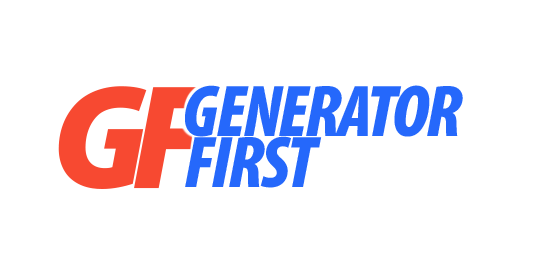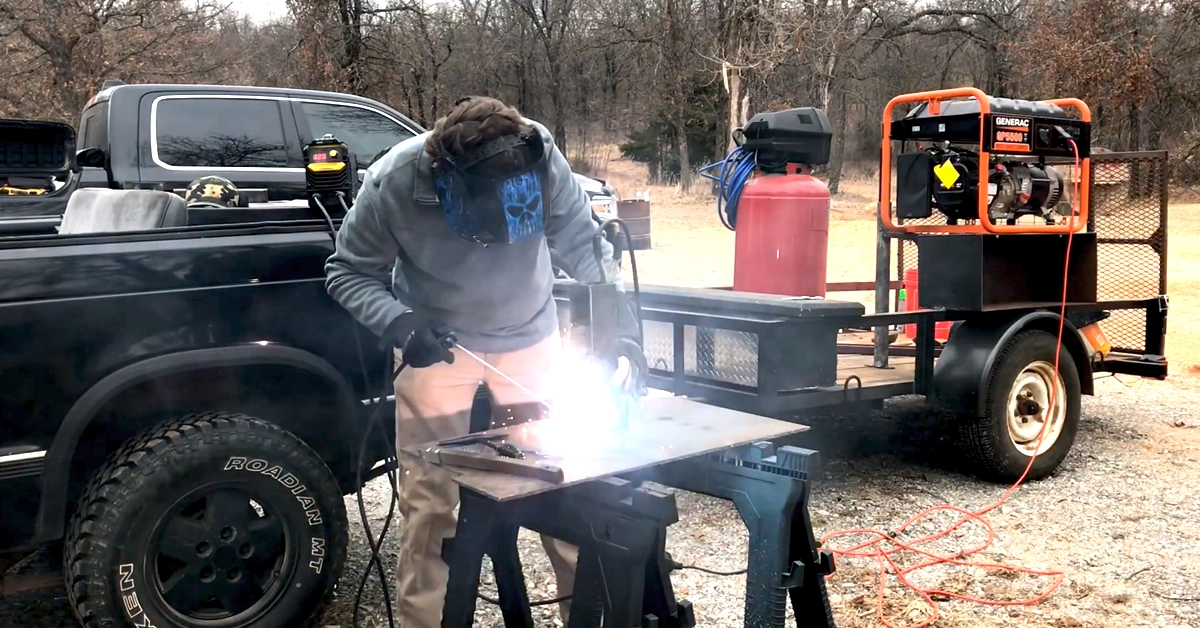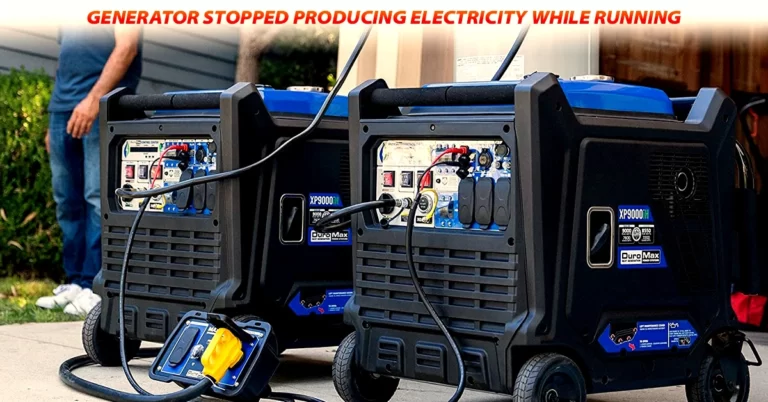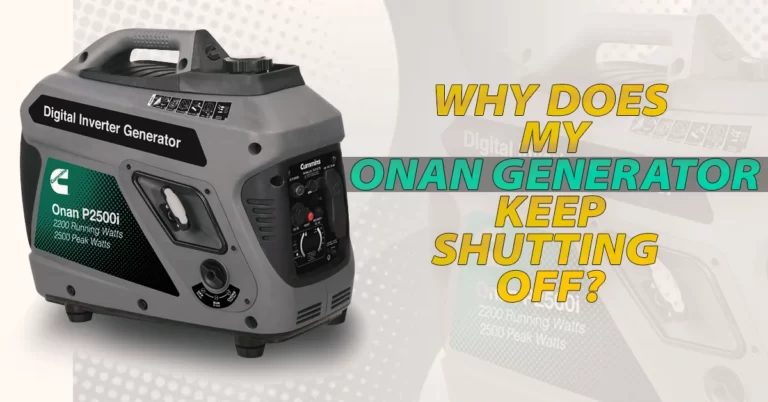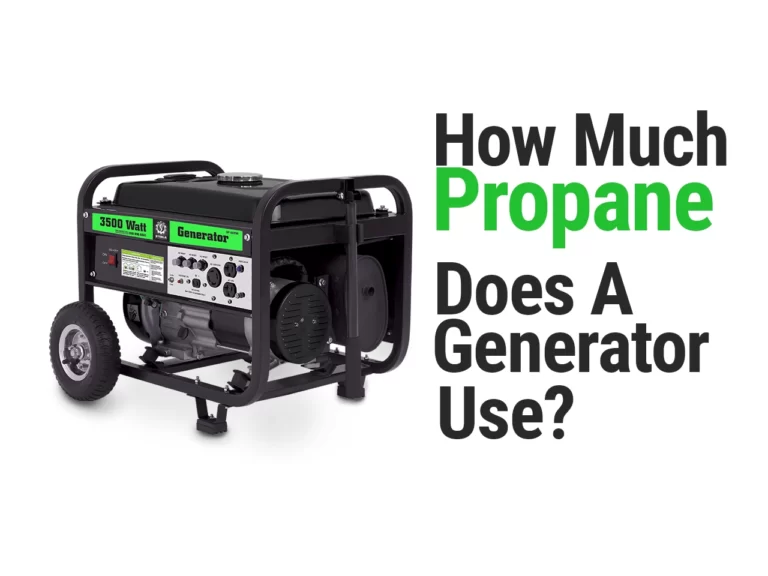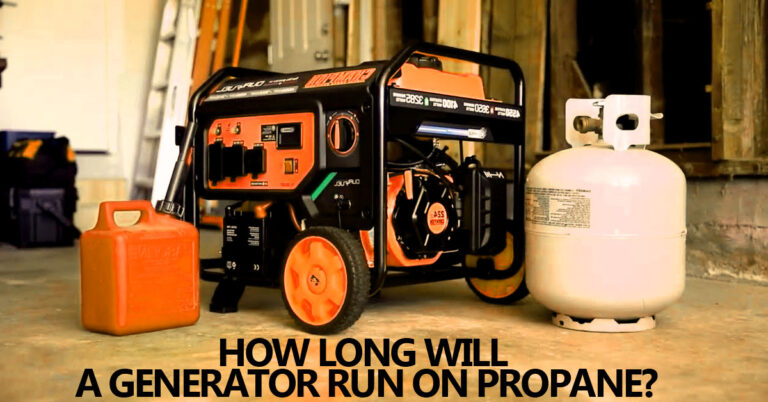Can You Run A Stick Welder On A Generator?
During a recent power outage in Seattle, as a professional welder, I faced the challenge of his business being temporarily shut down.
After researching online, I discovered that a stick welder could be used with a generator, which excited my curiosity. I had several questions about running a stick welder on a generator, including what size generator I need to run a welder and how many watts a welder needs. Or what size generator to run a welder. In the following text, I will answer Can You Run A Stick Welder On A Generator? and other questions. Keep reading to learn more.
Generator for Welder: Things to Consider
Type of generator
Portable generators are commonly used for running stick welders and offer a range of sizes and power outputs. These versatile welding tools can be powered by various fuels such as gasoline, propane, and diesel. When choosing a generator for welding, a portable generator is often considered the ideal choice.
Standby generators are widely employed in residential, industrial, and office settings. They can also be utilized for welding purposes. However, the common concern is determining the appropriate generator size for a welder before choosing between standby or portable generator.
How to Figure Out What Size Generator to Use for Your Welder
As a professional welder, I often receive numerous inquiries from people, and some of the common questions are mentioned below.
- what size generator to run 140 amp welder
- Will a 3000-watt generator run a welder?
- Will a 5000-watt generator run a welder?
- What size generator do I need to run an inverter welder?
- what size generator to run the Lincoln 225 welder
- how big of a generator to pull a stick welder
All these inquiries revolve around a central question: What generator size is required to power a stick welder?
This is how you do it
Generators come in various sizes and options, allowing you to select the right one for your requirements. When choosing a generator for welding, consider the voltage options (120 volts, 240 volts, or both) based on your welding machine’s specifications. Here’s the key point: Generators are rated in watts, while welders are rated in amperage. To ensure the welder achieves its rated amperage, you need to calculate the required wattage for the welder.
How many watt generator do i need to run a welder
To calculate the wattage needed, you can use a simple formula:
Watts = Volts x Amps
- Volts: Volts measure the “push” in electricity, like water pressure in pipes.
- Amps: Amps quantify the flow of electrical current, similar to the water flow rate in pipes.
- Watts measure the heat energy generated as electrons flow through a circuit.
- Determining Power Requirements: Multiply the voltage and amps a welder uses to determine the necessary power supply.
EXAMPLE 1:
1- Find your welder’s input power
Find the power & current levels
To operate a stick welder, consult the manual for power voltage and input current specifications. Pay attention to the power voltage (V) requirement, which indicates the required input voltage for your equipment or device.
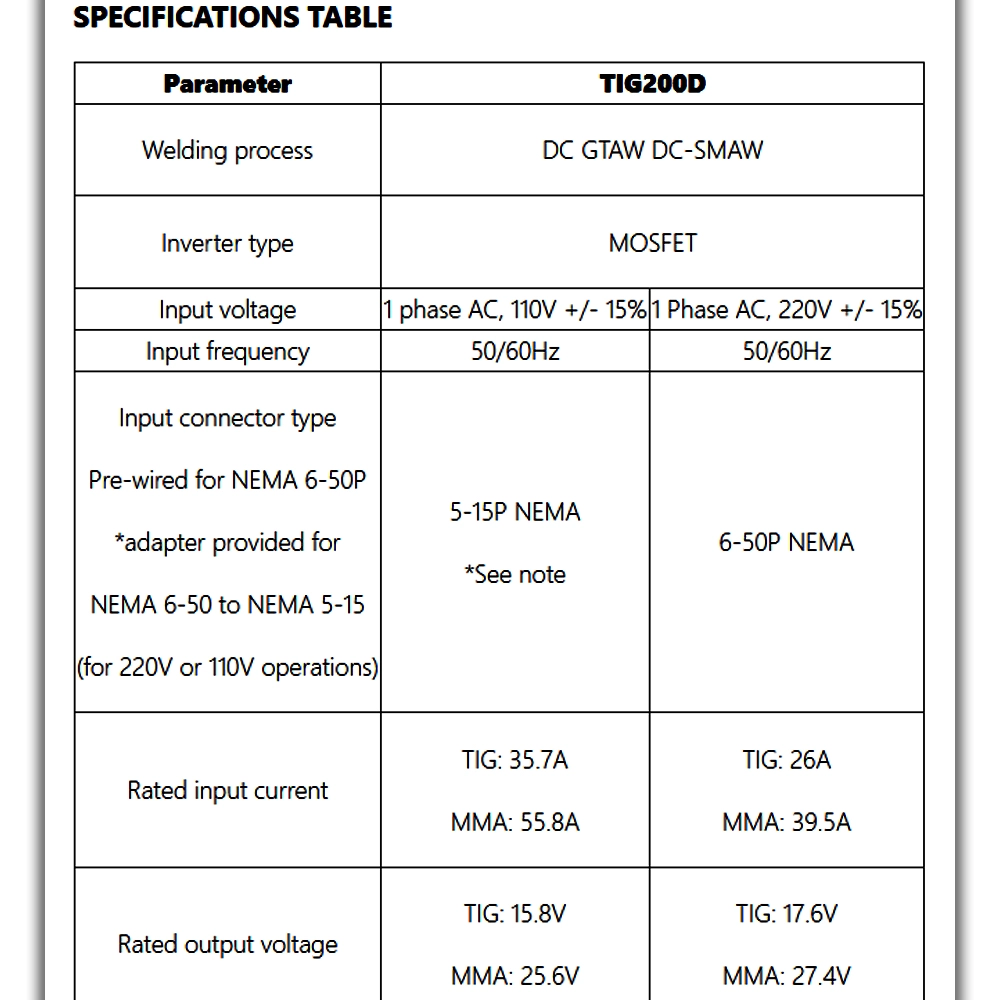
Consider the “+15 percent” rule: It is advisable to include an additional 15 percent to the input voltage when determining the power requirements for your portable generator.
Example calculations:
- 110 volts + 15% = 126.5 volts
Consequently, you require a generator capable of providing a minimum of 126.5 volts of power.
- 220 volts + 15% = 253 volts
In this scenario, you need a generator that can deliver a minimum of 253 volts of power, considering the “+15 percent” guideline.
Step 2: Calculate the input current
Determining Power Requirements To ensure sufficient power for your welder, it is essential to calculate the input current for both the 110-volt and 220-volt sides.
110-Volt Side, The highest input current on the 110-volt side is 55.8 amps.
Calculating Power
126.5 volts x 55.8 amps = 7058.7 watts
The calculated value is 7,058.7 watts, indicating the necessary “running watts” for your welder.
Including Safety Margin
Add 30 percent to the calculated power to account for startup power. In this instance, it would be 30 percent of 7,058.7 watts, resulting in an extra 2,117.6 watts.
220-Volt Side
The input current on the 220-volt side is 39.5 amps.
Calculating Power
220 volts x 39.5 amps = 8690 WATTS
This results in a power requirement of 8,690 watts for the operating load.
Including Safety Margin
Include a 30 percent safety margin for starting power requirements. In this case, the 30 percent of 8,690 watts amounts to an additional 2,607 watts.
Why safety margin is important: A safety margin prevents voltage drops, frequency fluctuations, and equipment issues. It keeps the generator operating optimally, providing a stable power supply for welding without risking malfunctions or damage.
Power Requirements for Different Modes
- 110-Volt Mode: For the exclusive use of the welder in 110-volt mode, a generator with a capacity of 8,000 watts (8 KW) for running is necessary. Consider a 30 percent safety margin, adding an extra 2,000 watts for starting and demand spikes. Therefore, a welder generator rated at 8,000 watts for running and 10,000 peak watts would be suitable.
- 220-Volt Mode: To run the welder at full power on the 220-volt side, a welder generator with a rating of 8,690 watts running and 11,297 watts peak would be suitable.
Example 2:
Appliance labels can vary, including the Titanium MIG label provided here, which displays power output and current output information. These specifications are crucial in determining the wattage output of your generator for welding purposes.

FOR 170 VERSION:
240 volts input x 26.8 amps = 6432 watts
Starting a power tool typically requires more power than needed to sustain the operation. Generator manufacturers recommend adding up to 30% more power to the running watts to accommodate starting devices.
Adding 30% safety margin:
6432 watts x.30 = 1929.6 watts
6432 +1929.6 = 8361.6
The welder requires a generator with a minimum operating wattage of 8500 watts and a peak rating of 9000 watts.
Other than the stick welder, are there any other tools being used?
When operating other equipment alongside the welding equipment using the same generator, it is important to calculate the power requirement for each device. It is advisable to overestimate the power required to avoid potential safety hazards that may arise from underestimating the power requirements.
Example 3:
Example Calculation -EVERLAST POWERARC 160ISTH

Let’s examine the process of sizing a generator for a specific welding machine, using the Everlast POWERARC 160ISTH as an example.
A. Voltage: 240 volts, Amperage: 28.8 amps
The Everlast POWERARC 160ISTH has a voltage rating of 240 volts and an amp rating of 28.8.2 amps, which are crucial in determining the maximum wattage requirement for a welding machine.
Calculation
28.8 amps x 240 volts = 6912 maximum watts
This figure represents the maximum power consumption required for welding devices to operate efficiently.
Manufacturer’s recommendation: Minimum 6000-watt surge generator
According to the Everlast POWERARC 160ISTH manual, a 6,000-watt surge is recommended to power the welding machine. This recommendation ensures that the generator can handle the peak power demands, including startup surges and continuous operation of the welding equipment.
Take away notes:
Adding Specified Tolerance:
When performing your calculations, it is essential to factor in the specified tolerance, such as a range of plus or minus 15 percent.
Starting Surge:
Unless the value “I1max” already considers the starting surge, include an additional 30 percent to the total wattage to accommodate the starting surge.
Alternative Names for Input Values:
- Input values may have varying names for denoting input values, such as input voltage, max power, V max or Vmax, U max or Umax, or U1max.
- The input current can be referred to as max amperage, max current, A max, I max, or I1max.
- “1max” specifically indicates the main input power.
Sizing a Generator for Welding:
- Finding the manufacturer’s voltage rating (U₁) for accuracy
- When calculating the maximum wattage, it is crucial to consider the voltage ratio specified by the manufacturer. Generators are typically rated for 120 and 240 volts, while welders may have different voltage ratings, such as 110 and 230 volts. To ensure accurate calculations, refer to the manufacturer’s voltage rating (U1) on the welder data plate.
- Identifying the best amperage value (I1max) for the maximum rated supply current
- When considering welders, the I1max value holds the utmost importance as it represents the maximum current during startup and is crucial for generator sizing. When determining the suitable generator capacity, it is advisable to prioritize the I1max value, also called the maximum “inrush” or “surge” current.
- Multiplying I1max by the voltage rating to calculate the maximum required watts
- To calculate the maximum wattage needed for your welding machine, multiply the I1max amperage value by the manufacturer’s voltage rating.
I2 or I2max:
I2 or I2max refers to the output power.
I1max Rating:
If utilizing the I1max rating, which already considers surge or starting watts, adding an extra 30 percent is not required.
Kilovolt Amp (KVA):
Generators for welders sometimes use the unit Kilovolt Amp or KVA, where 1 KVA is equivalent to 1 Kilowatt (KW), obtained by multiplying 1,000 volts by 1 amp.
Volts x Amps = Watts:
- Generator specifications are often expressed in KVA (kilovolt ampere), which can be converted to watts by multiplying the KVA rating by 800. For example, if we have a generator with a rating of 10 KVA, we can convert it to watts by multiplying ten by 800.
- 10 kVa x 800 = 8000 watts
- Hence, a generator rated at 10 KVA would have an output capacity of 8,000 watts. This conversion allows for evaluating and comparing the power capabilities of various generators, providing a standardized unit of measurement.
Startup or surge watt rating for brief output spikes
Generators are equipped with surge power to handle temporary power spikes during device startup. This capability ensures the generator can accommodate increased power demands without encountering performance issues.
Differentiation of running and surge watts in model names
When exploring generator menus, it is crucial to ascertain whether the specified wattage values refer to running or surge watts. Understanding this distinction enables users to accurately gauge the generator’s power output capacity and select one that fulfills their power requirements.
Other Factors Affecting: What size generator to run a welder
High Altitude Issues
Gasoline, diesel, and propane engines may experience reduced efficiency at high altitudes due to lower oxygen levels.
“At high altitudes, reduced air density due to lower air pressure can pose challenges for generator startup and performance. Insufficient oxygen availability for combustion may lead to difficulties and decreased performance.”
Welding generators experience a decrease in power output at higher altitudes compared to sea levels. According to generator experts, there is a 3.5% power loss for every 1000 feet of elevation.
Onan genertor about maunal guideline about High Altitude Issues

Extra Tools and Equipment
When using additional tools with a welder, it is important to ensure the generator has sufficient power capacity. For tools requiring 2000 watts, a generator with a capacity of at least 2500 watts is recommended. Remember to consider the wattage of other appliances like fans, heaters, and freezers powered by the generator.
Here’s a list of common devices and their power requirements:
| Appliance | Running Watts | Starting Watts |
|---|---|---|
| Coffee Maker | 1750 | 0 |
| 625W Microwave | 625 | 800 |
| Single 60W equivalent CFL bulb | 15 | 0 |
| Radio | 50-200 | 0 |
| Room Air Conditioner: 10,000 BTU | 1500 | 2200 |
| Small Appliance | 200 | 1700 |
| 8in. Bench Grinder | 1400 | 2500 |
| Pressure Washer: 1 HP | 1200 | 3600 |
| 7-1/4in. Circular Saw | 1400 | 2300 |
| Electric Chain Saw: 14in. Bar, 2 HP | 1100 | 0 |
| 10in. Table Saw | 1800 | 4500 |
| Drill: 3/8in., 4 Amps | 440 | 600 |
| Drill: 1/2in., 5.4 Amps | 600 | 900 |
| Portable Heater (Kerosene, Diesel Fuel): 90,000 BTU | 500 | 725 |
| Battery Charger: 60 Amp with 250 Amp Boost | 1500/5750 | 0 |
| Laptop | 65 | 0 |
| LCD Computer Monitor | 25 | 0 |
| Inkjet Printer | 15 | 0 |
| Tablet | 12 | 0 |
| Cell Phone Charger | 10 | 0 |
How Long Is the Run Time?
When choosing a generator for a welder, consider the run time, fuel capacity, and consumption rate. Factors such as power output, reliability, and likability also play a role in selecting the right generator for welding appliances.
Noise
When choosing a generator for welding, it is important to consider the noise factor for several reasons. Excessive noise can hinder concentration and comfort during welding tasks and may even cause hearing damage to welders. Minimizing noise helps prevent disturbances in the surrounding environment. It ensures a safe and comfortable working environment for welders, protecting their hearing health. Additionally, choosing a generator with lower noise levels minimizes the impact on the surrounding community.
Placement
When connecting welding appliances to generators, it is important to consider the length of the extension cord by the recommendations of the National Electrical Manufacturers Association (NEMA). An extension cord compliant with NEMA guidelines ensures a safe and proper electrical connection between the welder and the generator.
- NEMA stands for the National Electrical Manufacturers Association. It is an organization that sets standards for electrical equipment and systems in the United States. NEMA provides guidelines and specifications for various electrical products, including extension cords.
“Dirty” vs. Clean Power Generators for Welders
When selecting a generator for a welder, there are two main types to consider:
- dirty power generators
- clean power generator
Traditional transformer-based welder:
- These welders employ large copper and aluminum transformers to convert AC input current into high amperage DC low voltage electricity.
- They are reliable and not sensitive to dirt power, meaning every generator works well with them.
Intra-style welders:
- These welders feature advanced technology and a compact transformer design, resulting in a lighter weight than traditional welders.
- These welders achieve a stable output by utilizing capacitors that store high voltage.
- High-quality input electricity is essential for the optimal performance of these advanced electronics.
Issue of dirty power:
- Generators often produce “dirty power” with voltage and frequency fluctuations (THD), which can harm sensitive electronics. Older MOSFET inverter welders are more vulnerable, while newer IGBT-based machines still need a 5% or less THD generator.
How to Run a Stick Welder on a Generator?
Select the Proper Generator
Choosing the appropriate generator for your equipment is crucial to power your stick welder using a generator.
Connect the Stick Welder to the Generator
Next, connect your stick welder to the selected generator.
Start the Generator
After ensuring all connections and switches are secure, start the generator.
Begin Welding!
With everything set up, you can now start welding. Remember to maintain professionalism and follow proper welding techniques.
Generators for Welders
Generator for welders and compared conventional generators to inverter generators. Modern-day portable generators are compact and reliable for powering welders and tools and providing electricity for lights, refrigerators, and other appliances during power outages.
Conventional generators are motor-driven AC alternators that produce power at 3600 RPM, generating 120 volts at a frequency of 60Hz. However, they can experience voltage and frequency fluctuations due to harmonic distortion. The power generated may not be clean. Traditional welders, particularly inverted welders needing 5% or less total harmonic distortion (THD), can still operate with conventional generators.
Inverter generators utilize inverter technology to produce clean power. They generate high-frequency AC using engine-driven alternators, converted to DC and inverted back into a lower, more stable AC supply current. This process allows inverter generators to generate a stable sine wave with minimal total harmonic distortion (THD), typically below 5%. This makes them suitable for powering sensitive electronics inverters and traditional welders.
Tips For Welding With A Generator
Size the generator correctly:
To ensure the right fit, it’s recommended to select a generator size that matches your welder’s wattage. Determine the welder’s wattage by multiplying the maximum amps (I1max) by the voltage (U1), which can be found on the data plate or manual. Additionally, consider other appliances and tools like refrigerators, freezers, and fans that may require power.
Generator Sizing Chart for Welders
| Welder Amperage | Minimum Generator Size | Recommended Generator Size |
|---|---|---|
| Up to 100A | 3000 watts | 4500 watts |
| 120–160A | 4500 watts | 6500 watts |
| 180–200A | 6500 watts | 8000 watts |
| 210–250A | 10000 watts | 13000 watts |
Avoid undersized generators:
Using undersized generators can result in significant voltage and frequency spikes, which can strain the generator and the welder. It can also make the welding process more difficult.
Choose a generator with extra capacity:
For optimal performance, voltage stability, and handling spikes, ensure your generator produces at least 30 to 40% more watts than you need.
Optimal load capacity:
Generators operating at 50-60% capacity are more capable of handling load fluctuations than those running at 90% or higher.
Starting and shutdown:
Before turning off your generator, unplug your welder and other equipment.
Disable auto-idle feature:
When your generator is connected to the load, disable the fuel-saving feature if enabled, as it causes the generator to run at full speed.
Ensure an adequate fuel supply:
To ensure a smooth welding experience, ensure your generator is filled with fresh fuel before starting, which helps avoid welding interruptions.
Maintain the generator:
Proper generator maintenance helps ensure the optimal operation of your welding machine.
Use proper power/extension cords:
For safe and efficient operation, use the correct size extension cord, avoid low-quality or damaged cords, and follow the guidelines provided by the generator and welding machine manufacturers before connecting them.
What Are the Reasons To Run A Stick Welder On A Generator?
There are several reasons why you might choose to use a generator to power a stick welder, such as:
You Are Welding In An Emergency
A generator can provide the electricity needed to operate a stick welder in natural disasters or emergencies where a reliable power supply is unavailable.
Off-Grid Welding Takes Place
When working on a project not connected to the electrical grid, a generator can supply the necessary electricity to run your welder.
You’re Welding In A Dangerous Situation
A generator can offer a safer power supply for your stick welder in environments prone to electrical risks, such as near water or in explosive areas.
When Bad AC Electricity Is Present
When the AC power in your workspace is unreliable or unpredictable, a generator can offer your welder a more stable power supply.
It would help if you Were Movable.
Suppose you need to move your welder to multiple locations. In that case, a portable generator can offer a convenient and transportable power supply solution.
A Backup Power Source Is Required
For those whose line of work relies on a stick welder, having a backup power supply is crucial in case of power outages or disruptions. A generator serves as a reliable emergency power source in such situations.
A Gigger Power Capacity Is Required
When your welder requires more power than a standard home outlet can, a generator can offer the additional power you need.
You Are Employed At A Distant Location
In remote areas without access to the power grid, a generator can supply the necessary electricity to run your stick welder.
What Are Generator Modifications To Run A Stick Welder?
Modifying a generator for welding purposes can be complex and time-consuming, requiring electrical knowledge. Adding an auxiliary outlet box is one option, but it is laborious. Connecting the generator to an extension cord may need to provide more power for larger welding projects. Modifying the generator in other ways is possible but not recommended for beginners.
The simplest and most cost-effective solution is purchasing a generator designed for welding with the appropriate voltage output. This eliminates the need for modifications and ensures compatibility.
Considering the expenses associated with generators and welding as a hobby, it is generally not worth the time and effort to modify a generator for a stick welder. Purchasing a generator with the correct voltage output from the beginning is advisable to avoid any uncertainties.
What Are The Advantages Of Using A Stick Welder Generator?
Convenience: Generators provide the convenience of portability, allowing easy transportation to different project locations.
Cost savings: Using a generator for welding saves money, especially when there’s no access to a power outlet. Generators are generally more affordable to operate than other fuel sources.
Fuel efficiency: Generators consume less gas per hour than combustion engines, saving additional costs.
Ease of use: Generators are user-friendly and simple to operate. Connect the generator, and you can start welding without requiring advanced electrical training.
Time savings: The straightforward setup of connecting a generator to a stick welder saves time, especially during extended welding projects, eliminating the need for complex procedures.
What Are The Disadvantages Of Using A Stick Welder On A Generator?
When using a generator for welding, there are important considerations to keep in mind:
Unreliable electricity: Generators may cause voltage fluctuations, hindering welding and potentially damaging the welder.
Low amperage output: Generators often need to provide more amps for proper welder operation.
Limited power capacity: Generators may need help with high power demands in certain welding applications, impacting performance and weld quality.
Increased maintenance requirements: Running a welder on a generator may require more frequent maintenance for both the generator and the welder.
Noise and exhaust emissions: Generators can be noisy and emit fumes, so precautions are needed for a safe working environment.
Consider these factors to ensure a successful welding experience with a generator.
What Is A Stick Welder?
Stick welding, also known as shield metal arc welding (SMAW), is a process in which an electrode, commonly called a “stick,” creates an arc between the electrode and the metal being welded. Stick welding is a slang term for the stick-like electrodes used in welding.
In stick welding, a constant voltage (CV) power supply generates electricity that melts the metal joint and electrodes in unison, leading to the fusion of two joint pieces with the help of filler metal.
End Words
You can successfully run a welding tool on a generator with careful consideration and the right equipment. By choosing a generator with the appropriate voltage output and following the recommended guidelines, you can ensure a safe and efficient welding experience. So, if you’re wondering, “Can you run a stick welder on a generator?” the answer is yes, as long as you make informed decisions and prioritize compatibility. Now you can confidently power your welder’s equipment with a generator and easily tackle your welding projects.
FAQs
How do I determine the appropriate size of generator needed to run a welding machine?
The generator’s size depends on your stick welder’s maximum output. As a general guide, you would need a generator with a minimum capacity ranging from 6 kVA to 13 kVA, depending on the maximum output of the welder.
How many watts are required to power a welding machine?
The wattage requirement for a stick welder varies depending on the specific model and its power consumption. For the precise wattage needed, it is advised to refer to the manufacturer’s requirements or reference the welder’s manual.
Will a 3500-watt generator run a stick welding machine?
It depends on your stick welder’s power requirements. A 3500-watt generator can work for lower-amperage welders, but higher-amperage models may require more power. Check your welder’s specifications for compatibility.
What is a good generator to run a welder?
A good generator to run a welder would meet your welder’s power requirements, have a stable power output, and be reliable. Choosing a generator from reputable brands known for producing quality and durable power equipment is recommended.
How many volts does a stick welder use?
Stick welders commonly operate between 120 and 240 volts depending on the product and power needs. Some have dual voltage capability, allowing them to operate on 120 and 240 volts.
How many amps does a welder use?
Stick welders have variable amperage usage based on the model and welding application. They range from as low as 50 amps for lighter tasks to several hundred amps for heavy-duty welding.
Does stick welding uses a lot of electricity?
Stick welding has a notable electricity consumption, particularly when used at higher amperages. The amount of power consumed will vary based on factors such as the amperage setting, duration of use, and the specific stick welding process being utilized.
How many amps are in 7018 stick welding?
Easy to use in all welding positions, with excellent arc stability, low spatter levels, and easy slag removal. Amperage Range: Minimum: 90 amps. Maximum: 150 amps.
How strong is stick welding?
Stick welding is a reliable method for creating robust and long-lasting welds. When performed correctly, stick welding produces welds with high tensile strength, making them well-suited for a wide range of applications in industries like construction, fabrication, and maintenance.
Is a welder AC or DC?
Depending on the specific model, welders can be AC (alternating current) or DC (direct current). Some stick welders are designed to work with AC power sources, while others are designed for DC power sources. Some welders offer the versatility to switch between AC and DC modes.
Is stick welding stronger than wire?
The strength of a weld is influenced by factors such as the welding process, technique, and materials used. Stick welding and wire welding (like MIG welding) can produce strong welds if executed properly. The welding process selection depends on the specific application and the welder’s preference.
Can you get shocked by stick welding?
Stick welding carries the potential for electric shock due to the high voltage and current involved. To ensure safety, it is crucial to wear suitable protective gear, work in a well-ventilated space, and follow safety guidelines diligently. These measures help mitigate the risk of electric shock during stick welding.
